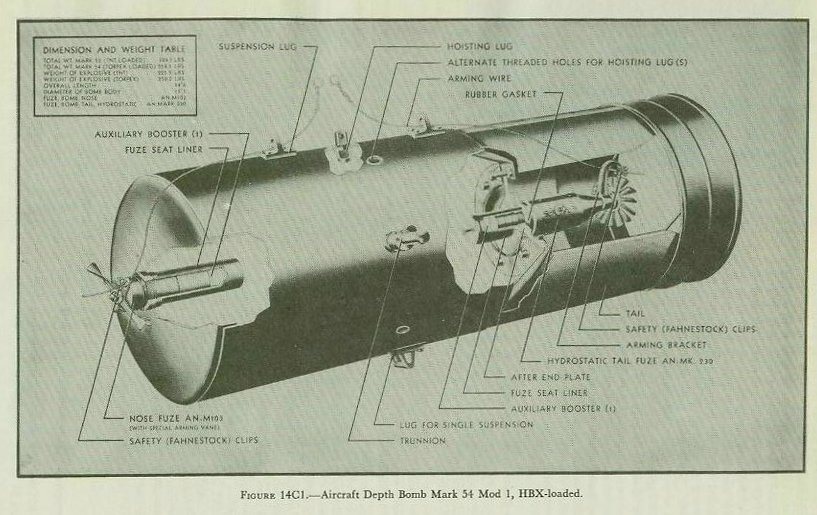| GENE SLOVER'S US NAVY PAGES NAVAL ORDNANCE AND GUNNERY VOLUME 1, NAVAL ORDNANCE CHAPTER 14 ANTISUBMARINE WEAPONS |
| HOME INDEX Antisubmarine Weapons A. Antisubmarine warfare B. Depth charges C. Depth bombs D. Throwing weapons E. Nets and booms |
| C. Depth Bombs 14C1. Description Figure 14C1 shows a current depth bomb, the HBX-loaded Mark 54 Mod 1. Depth bombs are sometimes defined as depth charges designed for dropping from aircraft. Depth bombs were among the major antisubmarine weapons used in World War II. Three methods of dropping-toss bombing, glide bombing, and low-altitude release-were employed. A depth bomb has a rather light case. The explosive filler comprises about 70 percent of the weight of the assembled bomb. To reduce the danger of ricochets at small entrance angles, the depth bomb has a flat nose. Fuzing arrangements are discussed in the next article. |
 |
 |
| 14C2. Fuzing When carried in aircraft with selective arming, depth bombs normally take two fuzes. An impact-type nose fuze with a special flat arming vane is installed for use against suitable surface or land targets. A hydrostatic tail fuze, shown in figure 14C2, is intended for use against submerged submarines. When the tail fuze is dropped armed, the nose fuze must be dropped safe. Otherwise the bomb will detonate on water entry. In planes that lack selective arming, only the tail fuze is used. During World War II, many depth bombs were fitted with an athwartship hydrostatic fuze. This feature, however, is not present ‘in the Depth Bomb Mark 54 Mod 1 shown in figure 14C1. The tail fuze shown in figure 14C2 allows five choices of depth setting, varying from 25 to 125 feet. Normally the depth setting is made before take-off, though it can be made aboard the planting aircraft. This gives an approximate control over the depth of the explosion. 14C3. Damage to target Like its close relative the depth charge, a depth bomb is unlikely to hit a submarine directly. Instead, it gains its effect by creating an underwater pressure wave that may weaken or crush the hull plates of the target. |